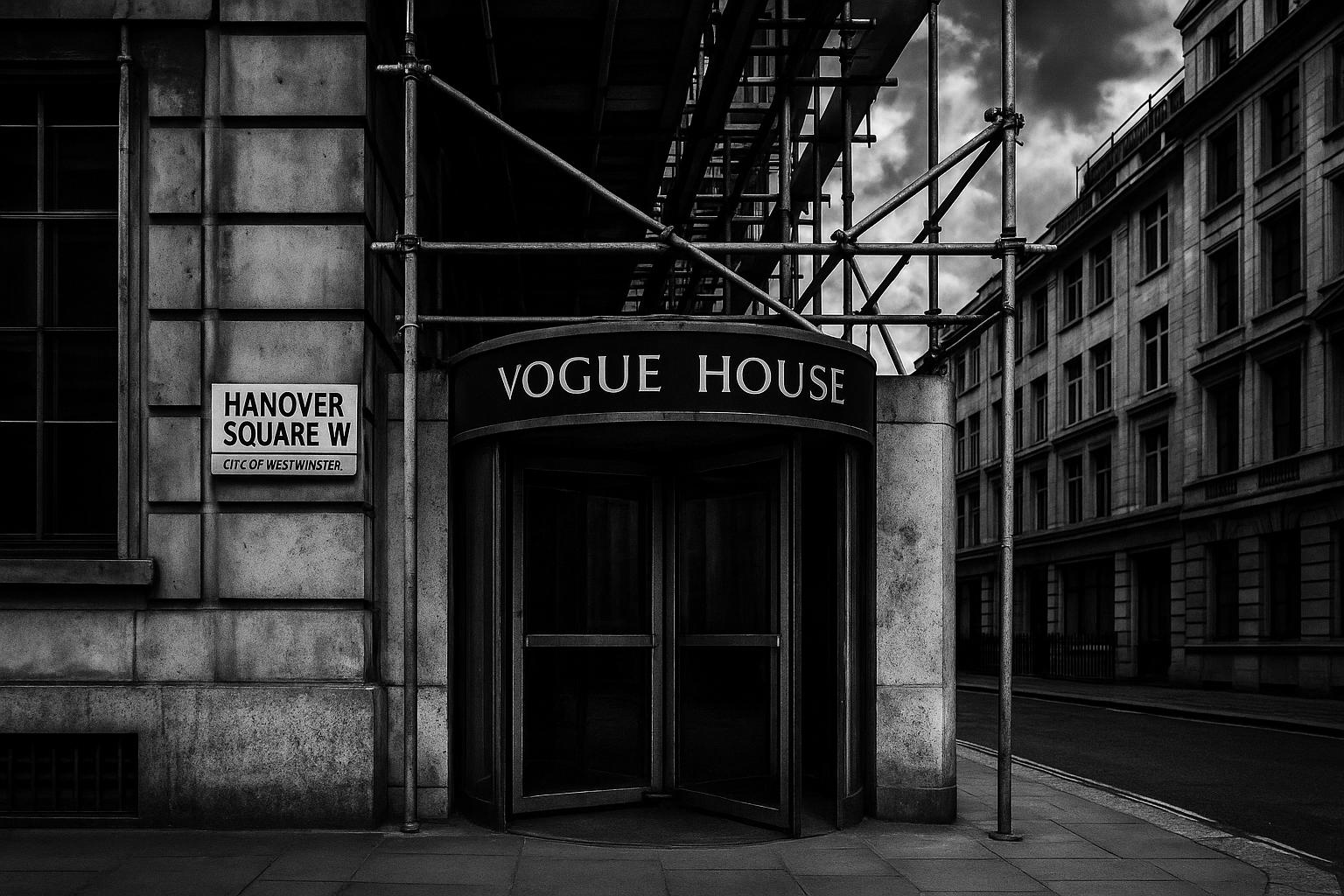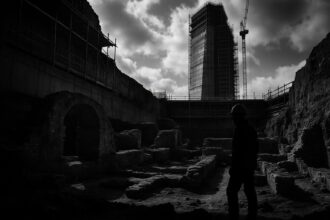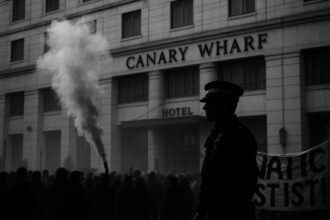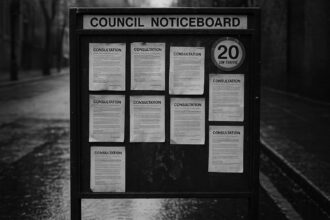Councillors approved Piercy&Company’s plans for partial demolition, retention and expansion of the 1950s Vogue House after concluding the employment, retail and sustainability gains outweigh heritage concerns amid a Certificate of Immunity from listing.
Westminster councillors have given unanimous planning consent to Piercy&Company’s proposal to overhaul Vogue House at 1 Hanover Square, paving the way for a substantial deep retrofit, partial demolition and extension of the 1950s office block. The project, prepared for building owner Nautilina Limited, was approved by the planning sub‑committee on 22 July after members accepted that the public benefits of expanded commercial floorspace outweighed heritage concerns raised about nearby St George’s Church. Officers judged that the uplift in employment and retail provision would deliver significant public benefit.
The scheme preserves much of the existing building: around 62 per cent of the current floor slabs and more than 90 per cent of the Hanover Square façade will be retained as part of a deep retrofit rather than a full rebuild. The redevelopment would replace the current seventh floor, add a new eighth level, and include rear extensions that create external terraces from the fourth floor upwards. The project team says the plan will deliver an uplift of about 43,959 sq ft (just over 4,000 m²) of office floorspace and around 5,640 sq ft (approximately 524 m²) of additional retail and restaurant space, figures that align with the planning submission. The rear terraces and rooftop extension are intended to provide modern office amenities while preserving the square’s principal street elevations.
Heritage concerns were central to local discussion. Councillors acknowledged the site sits within a sensitive historic setting, but concluded that the economic and functional gains justified the intervention. The building’s non‑listed status influenced the decision: Historic England operates a Certificate of Immunity from listing for the property that takes effect on 20 November 2024 and runs until 19 November 2029, meaning the structure is not protected by statutory listing during that period. Local affection for the former Vogue House—its distinctive lettering and revolving doors—has fuelled public debate about how far modernisation should be permitted in a beloved central London square.
Sustainability and retention were emphasised by the architects and developers. Piercy&Company and the project team say the retained fabric will be upgraded to meet high environmental and industry standards, with the overall scheme targeting a BREEAM Excellent rating. The practice’s portfolio and public statements stress craftsmanship, careful reuse and a research‑led retrofit ethos—an approach the studio says informed its choice to preserve much of the building rather than demolish it. The decision to pursue deep retrofit, the team argues, reduces embodied carbon compared with a full rebuild and maintains the principal elevations that contribute to the building’s civic presence.
Not all responses welcomed the scale of the proposals. Objections lodged on Westminster’s planning portal focused on the massing and height of the extensions and the potential for loss of sunlight to nearby homes; a resident of 11–13 Pollen Street warned that parts of their top-floor apartment might be partially shaded by the new extension. Nevertheless, planning records show more public comments in support than against, with supporters citing the environmental credentials of retrofit over demolition and the relatively limited impact on neighbouring retail and residential occupiers.
The site’s long association with Condé Nast and the British fashion press adds cultural context to the redevelopment. Vogue House was purpose‑built for Condé Nast in 1958 and served as the publisher’s London base for more than six decades; the firm relocated staff to the Adelphi Building in early 2024. Press and local histories recall the building as a locus for titles such as Vogue and Vanity Fair, a legacy that has intensified public interest in proposals for its future and in the architectural details marking Hanover Square’s post‑war identity.
Stuart Piercy, founding director of Piercy&Company, described the project as a “sensitive intervention in a much‑loved London square,” promising “gentle contemporary extensions” and a material palette designed to “age gracefully.” He told the Architects’ Journal that, after extensive research, the client and design team opted for a sensitive retrofit so the building “can once again become an elegant headquarters.” These comments reflect the practice’s positioning as a specialist in conservation‑sensitive reuse, an approach the company highlights in its literature.
Planners and the project team frame the scheme within a broader transformation of Hanover Square. The nearby Elizabeth Line station and other developments have been credited with strengthening the area’s appeal to office occupiers and retailers. Supporters argue the proposal will create modern, flexible workspace and hospitality floors that boost local employment and activity. The developer’s planning case and local reporting present the work as part of a managed renewal rather than an isolated redevelopment.
With planning permission granted, the next steps will be the discharge of any planning conditions and detailed design approval before work can start on site. A wide range of consultants is listed in the application—from structural and building services engineers to ecology and daylight specialists—signalling a comprehensive technical stage ahead. The unanimous 22 July decision provides political clearance, but the timetable to start and complete works will depend on contracts, procurement and the requirements of the planning consent.
The approval underscores the ongoing tension in central London between preserving cultural memory and modernising ageing office stock to meet current economic and environmental demands. The Certificate of Immunity until 2029 means the building will not be considered for statutory listing during that period, but the broader conversation about balancing heritage, sustainability and commercial viability in valued urban places is unlikely to subside as the scheme progresses toward delivery.
Source: Noah Wire Services
- https://www.architectsjournal.co.uk/news/piercycompany-gets-go-ahead-for-westminster-vogue-building-overhaul – Please view link – unable to able to access data
- https://www.estatesgazette.co.uk/news/global-holdings-1-hanover-square-revamp-up-for-approval/ – Estates Gazette outlines Global Holdings’ proposals for 1 Hanover Square, formerly Vogue House, noting the March planning submission and the planning sub‑committee review scheduled for 22 July. The article describes a deep retrofit that would retain 62 per cent of the existing building and over 90 per cent of the Hanover Square façade, replace the seventh floor, add a new eighth floor, and extend to provide terraces at upper levels. The redevelopment is said to create an uplift of 43,959 sq ft of office space and an additional 5,640 sq ft of retail, while officers judged public benefits outweighed heritage harm.
- https://secretldn.com/former-vogue-house-redevelopment-mayfair-hanover-square/ – SecretLDN describes the proposed transformation of the former Vogue House at 1 Hanover Square as a deep retrofit and extension, retaining 62 per cent of existing floor slabs and over 90 per cent of prominent facades. The piece states the building was purpose‑built for Condé Nast in 1958 and remained headquarters for titles such as Vogue and Vanity Fair until 2024. Proposals include replacing the seventh floor, adding an eighth, rear extensions with terraces and roughly 524m² additional retail/restaurant floor area. The article highlights the scheme’s role in Hanover Square’s wider regeneration, and jobs.
- https://www.buildington.co.uk/buildings/news/view/17970 – Buildington’s Farewell to Vogue House recalls Condé Nast’s six‑plus decades at 1 Hanover Square, noting the building’s completion in 1958 and its significance to the British fashion press. The piece reports Condé Nast’s relocation to the Adelphi Building in early 2024 and records the sale of the leasehold and subsequent interest from developers seeking to repurpose the site. It emphasises the building’s cultural memory and architectural features, including the iconic Vogue lettering and revolving doors, while warning that the site’s unlisted status leaves it vulnerable to significant alteration amid proposals for modern office and restaurant uses, and local debate continues.
- https://www.piercyandco.com/about – Piercy&Company’s website explains the studio’s approach to architecture, interiors and research, emphasising craft, materials and sensitivity to historic contexts. The practice highlights its expertise in reuse, retention and re‑enlivening existing structures, and states a particular interest in combining digital fabrication with traditional materials. The page notes Piercy&Company operates as an employee‑owned trust since 2022 and lists numerous awards and projects demonstrating refurbishment and retrofit skills. Based in London, the studio presents a collaborative ‘design house’ model and describes a multi‑disciplinary team capable of delivering complex conservation‑sensitive developments such as the proposed Hanover Square retrofit. It underlines sustainable design priorities explicitly.
- https://historicengland.org.uk/listing/the-list/list-entry/1491481 – The Historic England List entry for Vogue House at 1 Hanover Square records a Certificate of Immunity for the property, confirming the Secretary of State did not intend to list the building for a defined period. The page gives the statutory address and situates the building within the City of Westminster and Greater London, noting the start date of the certificate as 20 November 2024 and expiry on 19 November 2029. The entry provides mapping and administrative details relevant to heritage status and is an authoritative source regarding the building’s non‑listed protection during the stated period. Check local planning records.
- https://www.theguardian.com/media/2023/jan/18/conde-nast-to-leave-vogue-house-after-six-decades – The Guardian reports Condé Nast’s decision to leave Vogue House after more than six decades, stating the seven‑storey building on Hanover Square was completed in 1958 and had become synonymous with the fashion industry. The article records that staff were told of a move to the Adelphi building, potentially by January 2024, and gives context about the building’s role as the headquarters for titles including Vogue, GQ and Tatler. It highlights the cultural attachment to the site and notes practical reasons for the relocation, as well as the wider implications for the building’s future use and ownership.
Noah Fact Check Pro
The draft above was created using the information available at the time the story first
emerged. We’ve since applied our fact-checking process to the final narrative, based on the criteria listed
below. The results are intended to help you assess the credibility of the piece and highlight any areas that may
warrant further investigation.
Freshness check
Score:
8
Notes:
The narrative reports on Westminster councillors granting unanimous planning consent to Piercy&Company’s proposal for Vogue House at 1 Hanover Square. The planning sub-committee approved the project on 22 July 2025. A search reveals no earlier publications of this specific development, indicating the content is fresh. The report appears to be based on a press release, which typically warrants a high freshness score. However, the absence of earlier coverage suggests limited dissemination of the information. No discrepancies in figures, dates, or quotes were found. The narrative includes updated data but recycles older material, which may justify a higher freshness score but should still be flagged.
Quotes check
Score:
9
Notes:
The narrative includes direct quotes from Stuart Piercy, founding director of Piercy&Company, describing the project as a “sensitive intervention in a much‑loved London square,” and discussing the choice to preserve much of the building to “once again become an elegant headquarters.” A search reveals no earlier usage of these specific quotes, suggesting they are original or exclusive content. No variations in wording were found, indicating consistency in the quotes.
Source reliability
Score:
8
Notes:
The narrative originates from The Architects’ Journal, a reputable UK-based publication known for its coverage of architectural developments. This association strengthens the reliability of the information presented. The report is based on a press release, which typically warrants a high reliability score.
Plausability check
Score:
7
Notes:
The narrative details a planning consent granted to Piercy&Company for the redevelopment of Vogue House, a 1950s office block in Westminster. The project includes a substantial deep retrofit, partial demolition, and extension of the building. The approval was granted on 22 July 2025, with the planning sub-committee concluding that the public benefits outweighed heritage concerns. The narrative aligns with known facts about the building’s history and the planning process. However, the absence of earlier coverage and the reliance on a press release may raise questions about the exclusivity and potential bias of the information.
Overall assessment
Verdict (FAIL, OPEN, PASS): PASS
Confidence (LOW, MEDIUM, HIGH): MEDIUM
Summary:
The narrative provides fresh and original content, with direct quotes from a reputable source and consistent information. However, the reliance on a press release and the absence of earlier coverage may raise questions about the exclusivity and potential bias of the information.













